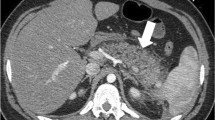Abstract
Objective
This study aimed to determine the level of 18F fluorodeoxyglucose (18F-FDG) activity in the normal adult appendix using positron emission tomography/computed tomography (PET/CT).
Materials and methods
We performed a retrospective review of PET/CT images using 18F-FDG in 563 consecutive asymptomatic adult patients without appendiceal pathology. We excluded 257 patients for an undetected or obscured appendix and three patients for appendicitis found on CT imaging. FDG uptake in the appendix was qualitatively and quantitatively assessed. The maximum standardized uptake value (SUVmax) was calculated for quantitative analysis with SUVmax of the normal liver for comparison. A total of 303 patients (200 males, 103 females, mean age of 66 years) were included in this study. Medical charts and histories were evaluated for patients who showed positive FDG accumulation. Pearson’s correlations between appendiceal SUVmax and age, body mass index, and blood glucose levels were analyzed.
Results
The mean appendiceal SUVmax was 1.14 (range 0.52–5.12) with an appendix-to-liver SUVmax ratio of 0.34 (range 0.06–1.28). Three patients qualitatively showed a positive FDG accumulation with appendiceal SUVmax greater than 3.00. There were no correlations between appendiceal SUVmax and age, body mass index, or blood glucose levels.
Conclusions
FDG in the normal adult appendix shows a low activity level and is lower compared with normal liver. However, the normal appendix can rarely show high FDG accumulation. In such cases, differentiation from appendiceal pathology solely by PET/CT images would be difficult.

Similar content being viewed by others
References
Toriihara A, Yoshida K, Umehara I, Shibuya H. Normal variants of bowel FDG uptake in dual-time-point PET/CT imaging. Ann Nucl Med. 2011;25(3):173–8.
Reavey HE, Adina L, Alazraki, Simoneaux SF. Normal patterns of 18F-FDG appendiceal uptake in children. Pediatr Radiol. 2014;44:398–402.
Purandare NC, Gandhi A, Puranik AD, Agrawal A, Shah S, Patil A, et al. Use of FDG/PET CT to diagnose malignancy as the cause of mucocele of the appendix. Indian J Gastroenterol. 2014;33(1):79–81.
Ogawa S, Itabashi M, Kameoka S. Significance of FD-PET in identification of diseases of the appendix- based on experience of two cases falsely positive for FDG accumulation. Case Rep Gastroenterol. 2009;3(1):125–30.
Koff SG, Sterbis JR, Davison JM, Montilla-Soler JL. A unique presentation of appendicitis: F-18 FDG PET/CT. Clin Nucl Med. 2006;31(11):704–6.
Sprinz C. Effects of blood glucose level on 18F-FDG uptake for PET/CT in normal organs: a systematic review. PLoS One. 2018;13(2):e0193140.
Mahmud MH, Nordin AJ, Saad FFA, Azman AZ. Impacts of biological and procedural factors on semiquantification uptake value of liver in fluorine-18 fluorodeoxyglucose positron emission tomography/computed tomography imaging. Quant Imaging Med Surg. 2015;5(5):700–7.
Kersah S, Partovi S, Traughber BJ, Muzic RF, Schluchter MD, O’Donnel JK, et al. Comparison of standardized uptake values in normal structures between PET/CT and PET/MRI in an oncology patient population. Mol Imaging Biol. 2013;15(6):776–85.
Cook GJ, Maisey MN, Fogelman I. Normal variants, artefacts and interpretative pitfalls in PET imaging with 18-fluoro-2-deoxyglucose and carbon-11 methionine. Eur J Nucl Med. 1999;26(10):1363–78.
Sarji AS. Physiological uptake in FDG PET simulating disease. Biomed Imaging Interv J. 2006;2(4):59.
Sprinz C, Altmayer S, Zanon M, Watte G, Irion K, Marchiori E, et al. Effect of blood glucose level on 18F-FDG uptake for PET/CT in normal organs: a systematic review. PloS One 13(2): e0193140.
Sprinz C, Zanon M, Altmayer S, Watte G, Irion K, Marchiori E, et al. Effects of blood glucose level on 18F fluorodeoxyglucose (18F-FDG) uptake for PET/CT in normal organs: an analysis on 5623 patients. Sci Rep. 2018;8:21–6.
Curtin KR, Fitzgerald SW, Nemcek AA, Hoff FL, Vogelzang RL. CT Diagnosis of acute appendicitis: imaging findings. AJR. 1995;164:905–9.
Athanasios N, Chalazonitis, Tzovara I, Sammouti E, Ptohis N, Sotiropoulou E, et al. CT in appendicitis. Diagn Interv Radiol. 2008;13:19–25.
Nakamoto Y, Tatsumi M, Hammoud D, Cohade C, Osman MM, Wahl RL. Normal FDG distribution patterns in the head and neck: PET/CT evaluation. Radiology. 2005;234:879–85.
Ganz ML, Wintfeld N, Li Q, Alas V, Langer J, Hammer M. The association of body mass index with the risk of type 2 diabetes: a case-control study nested in an electronic health records system in the United States. Diabetol Metab Synd. 2014;6:50.
Razi M, Bashir H, Hassan A, Niazi IK. False positive finding of F18-FDG in non-Hodgkin’s lymphoma; an inflamed appendix. J Pak Med Assoc. 2018;68(6):971.
Kaim AH, Weber B, Kurrer MO, Westera G, Schweitzer A, Gottschalk J, et al. 18F-FDG and 18F-FET uptake in experimental soft tissue infection. Eur J Nucl Med. 2002;29:648–54.
Lin CY, Ding HJ, Lin CC, Chen CC, Sun SS, Kao CH. Impact of age on FDG uptake in the liver on PET scan. Clin Imaging. 2010;34:348–50.
Büsing KA, Schönberg SO, Brade J, Wasser K. Impact of blood glucose, diabetes, insulin, and obesity on standardized uptake values in tumors and healthy organs on 18F-FDG PET/CT. Nucl Med Biol. 2013;40:206–13.
Acknowledgements
The authors would like to express special thanks to Mr Naoto Kunitake, medical student in our university, and we also thank Ellen Knapp, PhD, and Gillian Campbell, PhD, from Edanz Group (http://www.edanzediting.com/ac), for editing the draft of the manuscript. The authors declare they have no conflict of interest.
Funding
No funding was received for this work.
Author information
Authors and Affiliations
Corresponding author
Ethics declarations
Ethical considerations
All procedures followed were in accordance with the ethical standards of the responsible committee on human experimentation and with the Helsinki Declaration of 1975 (revised in 2008). This retrospective study was approved by our institutional review boards.
Additional information
Publisher’s Note
Springer Nature remains neutral with regard to jurisdictional claims in published maps and institutional affiliations.
Rights and permissions
About this article
Cite this article
Silman, C., Matsumoto, S., Ono, A. et al. 18F-FDG uptake in the normal appendix in adults: PET/CT evaluation. Ann Nucl Med 33, 265–268 (2019). https://doi.org/10.1007/s12149-019-01330-3
Received:
Accepted:
Published:
Issue Date:
DOI: https://doi.org/10.1007/s12149-019-01330-3




